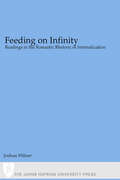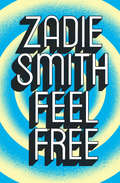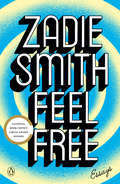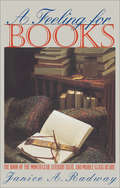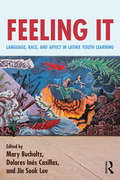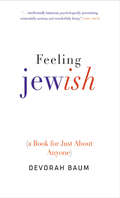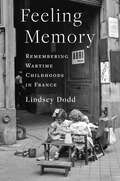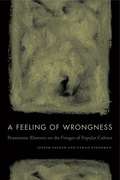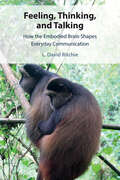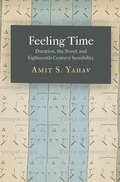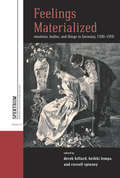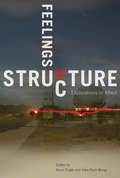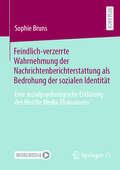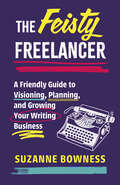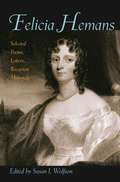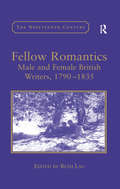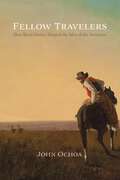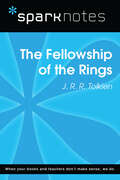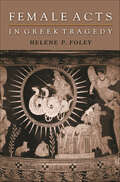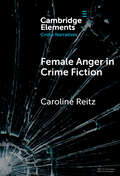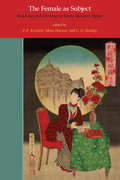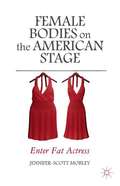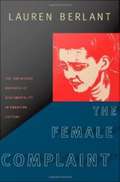- Table View
- List View
Feeding on Infinity: Readings in the Romantic Rhetoric of Internalization
by Joshua WilnerWhat "internalization" means for writers and critics of Romanticism, including Rousseau, Wordsworth, De Quincey, Baudelaire, Freud, Benjamin, and SedgwickWinner of the American Conference on Romanticism's Jean Pierre Barricelli Book Prize"Although defining Romanticism is a standing problem for literary history, some notion of internalization at the level of cultural tradition has recurrently been proposed as the solution to that problem... In this debate the notion of internalization tends to be handled... as a known quantity, whereas I am arguing that the notion itself remains obscure and thus that the problem of internalization and the problem of Romanticism may indeed, with respect to the discourse of literary history, be closely intertwined"—from Feeding on InfinityNotions of "internalization" play an important role in many contemporary fields of discourse, including literary history and theory, psychoanalysis, ideological critique, and learning theory in the social sciences. Indeed, the term "internalization" is pervasive and seems to answer a shared need of expression to such an extent that it is one of those technical words that has found its way into everyday use. But the meaning of this term and the continuities and discontinuities at work in its varied deployment have, for the most part, gone unanalyzed.In Feeding on Infinity, Joshua Wilner explores the power and limits of the discourse of internalization through the close reading of a variety of texts drawn from the Romantic tradition, a tradition which is both source for and oftentimes object of this discourse. Through the study of writers including Rousseau, Wordsworth, De Quincey, Baudelaire, Freud, Benjamin, and Sedgwick, he seeks to deepen our understanding of the problem of internalization, while situating its more or less explicit emergence as a problem in relation to the history of, in Gertrude Stein's phrase, "patriarchal poetics."Through patient attention to the transformations of rhetorical structures of representation and address performed by these works and to the frequent condensation of these transformations in figures of eating and drinking, Feeding on Infinity makes available to inquiry a surprisingly rich and largely unexplored network of connections within the "long" Romantic tradition. At the same time, it forges new links between deconstructive reading practices, psychoanalysis, and recent work in gender studies.
Feel Free
by Zadie SmithA timely, powerful collection of essays from one of our sharpest minds and most sparkling stylists. <p><p> How much joy can a person tolerate? How many kinds of boredom make up a life? Who owns the story of black America? Should Justin Bieber be more like Socrates? And why is there a dead art collector floating in the swimming pool? <p> Dazzlingly insightful, explosively funny and ever-timely, Zadie Smith is back with a second unmissable collection of essays. From German Old Masters to the new masters of East Coast rap, from social networks opening lines of communication to national referenda closing doors, Feel Free reaches out in all directions and draws back a rich feast of ideas. Here pop culture, high culture, social change and political debate all get the Zadie Smith treatment: dissected with razor-sharp intellect, set brilliantly against the context of the utterly contemporary, and considered with a deep humanity and compassion. <p> With the easy intimacy of a local and the piercing clarity of an outsider, Feel Free casts a sharp critical eye over the creative luminaries that have shaped our world: from J. G. Ballard to Karl Ove Knausgaard, Orson Welles to Charlie Kaufman, Joni Mitchell to Beyonce, and far beyond. And it considers the points of contact where the author herself meets this world, where the political meets the personal and critique meets memoir. This electrifying new collection showcases Zadie Smith as a true literary powerhouse, demonstrating once again her credentials as an essential voice of her generation.
Feel Free: Essays
by Zadie Smith<P>Arranged into five sections--In the World, In the Audience, In the Gallery, On the Bookshelf, and Feel Free--this new collection poses questions we immediately recognize. <P>What is The Social Network--and Facebook itself--really about? <P>"It's a cruel portrait of us: 500 million sentient people entrapped in the recent careless thoughts of a Harvard sophomore." <P>Why do we love libraries? <P>"Well-run libraries are filled with people because what a good library offers cannot be easily found elsewhere: an indoor public space in which you do not have to buy anything in order to stay." <P>What will we tell our granddaughters about our collective failure to address global warming? <P>"So I might say to her, look: the thing you have to appreciate is that we'd just been through a century of relativism and deconstruction, in which we were informed that most of our fondest-held principles were either uncertain or simple wishful thinking, and in many areas of our lives we had already been asked to accept that nothing is essential and everything changes--and this had taken the fight out of us somewhat."
Feeling Backward: Loss and the Politics of Queer History
by Heather LoveFeeling Backward weighs the costs of the contemporary move to the mainstream in lesbian and gay culture. While the widening tolerance for same-sex marriage and for gay-themed media brings clear benefits, gay assimilation entails other losses--losses that have been hard to identify or mourn, since many aspects of historical gay culture are so closely associated with the pain and shame of the closet.<P> Feeling Backward makes an effort to value aspects of historical gay experience that now threaten to disappear, branded as embarrassing evidence of the bad old days before Stonewall. It looks at early-twentieth-century queer novels often dismissed as "too depressing" and asks how we might value and reclaim the dark feelings that they represent. Heather Love argues that instead of moving on, we need to look backward and consider how this history continues to affect us in the present.<P> Through elegant readings of Walter Pater, Willa Cather, Radclyffe Hall, and Sylvia Townsend Warner, and through stimulating engagement with a range of critical sources, Feeling Backward argues for a form of politics attentive to social exclusion and its effects.
A Feeling for Books
by Janice A. RadwayDeftly melding ethnography, cultural history, literary criticism, and autobiographical reflection, A Feeling for Books is at once an engaging study of the Book-of-the-Month Club's influential role as a cultural institution and a profoundly personal meditation about the experience of reading. Janice Radway traces the history of the famous mail-order book club from its controversial founding in 1926 through its evolution into an enterprise uniquely successful in blending commerce and culture. Framing her historical narrative with writing of a more personal sort, Radway reflects on the contemporary role of the Book-of-the-Month Club in American cultural history and in her own life. Her detailed account of the standards and practices employed by the club's in-house editors is also an absorbing story of her interactions with those editors. Examining her experiences as a fourteen-year-old reader of the club's selections and, later, as a professor of literature, she offers a series of rigorously analytical yet deeply personal readings of such beloved novels as Marjorie Morningstar and To Kill a Mockingbird. Rich and rewarding, this book will captivate and delight anyone who is interested in the history of books and in the personal and transformative experience of reading.
Feeling It: Language, Race, and Affect in Latinx Youth Learning
by Mary Bucholtz Dolores Inés Casillas Jin Sook LeeFeeling It brings together twelve chapters from researchers in Chicanx studies, education, feminist studies, linguistics, and translation studies to offer a cohesive yet broad-ranging exploration of the issue of affect in the language and learning experiences of Latinx youth. Drawing on data from an innovative social justice-oriented university-community partnership based in young people’s social agency and their linguistic and cultural expertise, the contributors are unified by their focus on a single year in the history of this partnership; their analytic focus on race, language, and affect in educational contexts; and their shared commitment to ethnography, discourse analysis, and qualitative methods, informed by participatory and social justice paradigms for research with youth of color. Designed specifically for use in courses, with theoretical framing by the co-editors and ethnographic contributions from leading and emergent scholars, this book is an important and timely resource on affect, race, and social justice in the United States. Thanks to its interdisciplinary grounding, Feeling It will be of interest to future teachers and to researchers and students in applied linguistics, education, and Latinx studies, as well as related fields such as anthropology, communication, social psychology, and sociology.
Feeling Jewish: (A Book for Just About Anyone)
by Devorah BaumIn this sparkling debut, a young critic offers an original, passionate, and erudite account of what it means to feel Jewish—even when you’re not. Self-hatred. Guilt. Resentment. Paranoia. Hysteria. Overbearing Mother-Love. In this witty, insightful, and poignant book, Devorah Baum delves into fiction, film, memoir, and psychoanalysis to present a dazzlingly original exploration of a series of feelings famously associated with modern Jews. Reflecting on why Jews have so often been depicted, both by others and by themselves, as prone to “negative” feelings, she queries how negative these feelings really are. And as the pace of globalization leaves countless people feeling more marginalized, uprooted, and existentially threatened, she argues that such “Jewish” feelings are becoming increasingly common to us all. Ranging from Franz Kafka to Philip Roth, Sarah Bernhardt to Woody Allen, Anne Frank to Nathan Englander, Feeling Jewish bridges the usual fault lines between left and right, insider and outsider, Jew and Gentile, and even Semite and anti-Semite, to offer an indispensable guide for our divisive times.
Feeling Memory: Remembering Wartime Childhoods in France (The Columbia Oral History Series)
by Lindsey DoddWhat did it feel like to be a child in France during World War II? Feeling Memory is an affective exploration of children’s lives in wartime France and the ways they are remembered.Lindsey Dodd draws on the recorded oral narratives of a hundred people to examine the variety of experiences children had during the war. She considers different aspects of remembering, underscoring the centrality of emotion to memory. This book covers a wide range of locations—the country and the city, Occupied France and the Free Zone—and situations—well-off and poor children, those separated from their families and those with them; it places Jewish children’s experiences alongside non-Jewish children’s. Against the backdrop of momentous events, readers encounter children playing, working, eating, thinking, doing, and feeling.An investigation of the emotions of history, Feeling Memory argues for the transformative potential of affect theory and affective methodologies in oral history and the history of everyday life. This book makes major contributions to the history of France during World War II, understandings of children’s lives in war, and the use of memory in historical and oral history analysis.
A Feeling of Wrongness: Pessimistic Rhetoric on the Fringes of Popular Culture
by Joseph Packer Ethan StonemanIn A Feeling of Wrongness, Joseph Packer and Ethan Stoneman confront the rhetorical challenge inherent in the concept of pessimism by analyzing how it is represented in an eclectic range of texts on the fringes of popular culture, from adult animated cartoons to speculative fiction.Packer and Stoneman explore how narratives such as True Detective, Rick and Morty, Final Fantasy VII, Lovecraftian weird fiction, and the pop ideology of transhumanism are better suited to communicate pessimistic affect to their fans than most carefully argued philosophical treatises and polemics. They show how these popular nondiscursive texts successfully circumvent the typical defenses against pessimism identified by Peter Wessel Zapffe as distraction, isolation, anchoring, and sublimation. They twist genres, upend common tropes, and disturb conventional narrative structures in a way that catches their audience off guard, resulting in belief without cognition, a more rhetorically effective form of pessimism than philosophical pessimism.While philosophers and polemicists argue for pessimism in accord with the inherently optimistic structures of expressive thought or rhetoric, Packer and Stoneman show how popular texts are able to communicate their pessimism in ways that are paradoxically freed from the restrictive tools of optimism. A Feeling of Wrongness thus presents uncharted rhetorical possibilities for narrative, making visible the rhetorical efficacy of alternate ways and means of persuasion.
A Feeling of Wrongness: Pessimistic Rhetoric on the Fringes of Popular Culture
by Joseph Packer Ethan StonemanIn A Feeling of Wrongness, Joseph Packer and Ethan Stoneman confront the rhetorical challenge inherent in the concept of pessimism by analyzing how it is represented in an eclectic range of texts on the fringes of popular culture, from adult animated cartoons to speculative fiction.Packer and Stoneman explore how narratives such as True Detective, Rick and Morty, Final Fantasy VII, Lovecraftian weird fiction, and the pop ideology of transhumanism are better suited to communicate pessimistic affect to their fans than most carefully argued philosophical treatises and polemics. They show how these popular nondiscursive texts successfully circumvent the typical defenses against pessimism identified by Peter Wessel Zapffe as distraction, isolation, anchoring, and sublimation. They twist genres, upend common tropes, and disturb conventional narrative structures in a way that catches their audience off guard, resulting in belief without cognition, a more rhetorically effective form of pessimism than philosophical pessimism.While philosophers and polemicists argue for pessimism in accord with the inherently optimistic structures of expressive thought or rhetoric, Packer and Stoneman show how popular texts are able to communicate their pessimism in ways that are paradoxically freed from the restrictive tools of optimism. A Feeling of Wrongness thus presents uncharted rhetorical possibilities for narrative, making visible the rhetorical efficacy of alternate ways and means of persuasion.
Feeling, Thinking, and Talking: How the Embodied Brain Shapes Everyday Communication
by L. David RitchieThe way the brain, body, and mind interact with social structure to shape communication has so far not received the attention it deserves. This book addresses this gap by providing a novel account of communication as a social, biological and neurological force. Combining theories from communication studies and psycholinguistics, and drawing on biological and evolutionary perspectives, it shows how communication is inherently both biological and social, and that language and the neural systems that support it have evolved in response to a complex social environment. It introduces a clear set of terms based on current research, and illustrates key concepts using real-life examples from everyday conversation - speaking to a number of current debates around the evolutionary and biological basis of language, and the relationship between language, cognition, and environment. Thought provoking and engaging, it will change the way we think about the relationship between communication and cognition.
Feeling Time: Duration, the Novel, and Eighteenth-Century Sensibility
by Amit S. YahavLiterary historians have tended to associate the eighteenth century with the rise of the tyranny of the clock—the notion of time as ruled by mechanical chronometry. The transition to standardized scheduling and time-discipline, the often-told story goes, inevitably results in modernity's time-keeper societies and the characterization of modern experience as qualitatively diminished.In Feeling Time, Amit Yahav challenges this narrative of the triumph of chronometry and the consequent impoverishment of individual experience. She explores the fascination eighteenth-century writers had with the mental and affective processes through which human beings come not only to know that time has passed but also to feel the durations they inhabit. Yahav begins by elucidating discussions by Locke and Hume that examine how humans come to know time, noting how these philosophers often consider not only knowledge but also experience. She then turns to novels by Richardson, Sterne, and Radcliffe, attending to the material dimensions of literary language to show how novelists shape the temporal experience of readers through their formal choices. Along the way, she considers a wide range of eighteenth-century aesthetic and moral treatises, finding that these identify the subjective experience of duration as the crux of pleasure and judgment, described more as patterned durational activity than as static state.Feeling Time highlights the temporal underpinnings of the eighteenth century's culture of sensibility, arguing that novelists have often drawn on the logic of musical composition to make their writing an especially effective tool for exploring time and for shaping durational experience.
Feelings Materialized: Emotions, Bodies, and Things in Germany, 1500–1950 (Spektrum: Publications of the German Studies Association #21)
by Derek Hillard Heikki Lempa Russell SpinneyOf the many innovative historiographical approaches to emerge during the twenty-first century, one of the most productive has been the nexus of theories and methodologies broadly defined as “the history of emotions.” While this conceptual toolkit has generated significant insights into the past, it has overwhelmingly focused on emotions as linguistic and semantic phenomena. This edited volume looks instead to the material aspects of emotion in German culture, encompassing body, literature, photography, aesthetics, and a variety of other themes.
Feelings of Structure: Explorations in Affect
by Karen Engle Yoke-Sum Wong<p>Sweatsuits and the apocalypse, the demands of a sofa, a life recalled through window frames, whale watching through cancer, the serendipity of geographical names … in Feelings of Structure, these are just some of the spaces and places, memories, and experiences addressed by the authors in writings that are multilevel explorations of the tangled-up nature of feeling and structure. <p>Inspired by Raymond Williams's classic essay "Structures of Feeling" and influenced by the current discussion of affect studies, this collection inverts Williams's influential concept to explore the ephemerality of feeling as working in concert with the grounding forces of materiality and history. Feelings of Structure is a collection of twelve original texts that explores the weight of diverse encounters with a variety of configurations, be they institutional, spatial, historical, or fantastical. Featuring writers from a range of disciplines, this book aims for textual evocation in subject matter and approach, with essays that encompass multiple methodologies, writing styles, and tones. <p>Experimental in nature, Feelings of Structure balances the need for concrete and specific observation with the ephemerality of experience.</p>
Feindlich-verzerrte Wahrnehmung der Nachrichtenberichterstattung als Bedrohung der sozialen Identität: Eine sozialpsychologische Erklärung des Hostile Media Phänomens
by Sophie BrunsIm Zentrum dieser Arbeit steht die Frage, wie Mitglieder von sozialen Gruppen auf die Nachrichtenberichterstattung zu einem Thema reagieren, welches für ihre soziale Gruppe relevant ist. Mit der Zielsetzung, die Rolle der sozialen Identität für die feindlich-verzerrte Wahrnehmung der Nachrichtenberichterstattung und deren Konsequenzen zu untersuchen, befasst sich die Autorin mit einer sozialpsychologischen Erklärung des Hostile Media Phänomens. Aufbauend auf einer theoretischen Modellierung folgt eine empirische Prüfung des Erklärungsmodells mittels einer quantitativen Befragung mit experimenteller Untersuchungsanlage. Die Ergebnisse verdeutlichen insbesondere die Bedeutung der wahrgenommenen Bedrohung der sozialen Identität für die Konsequenzen der feindlich-verzerrten Wahrnehmung der Nachrichtenberichterstattung. Es zeigt sich beispielsweise, dass Gruppenmitglieder eher bereit sind, Journalistinnen und Journalisten verbal abzuwerten, wenn sie sich durch deren Berichterstattung in ihrer sozialen Identität bedroht sehen.
The Feisty Freelancer: A Friendly Guide to Visioning, Planning, and Growing Your Writing Business
by Suzanne BownessBuild your writing business into a thriving and satisfying career.Are you a feisty, creative person? Independent, ideas-driven, and ready to work hard for the lifestyle you deserve? If so, you may be a feisty freelancer. Freelancing is not for the faint of heart, but it offers many rewards: control over your own schedule, the opportunity to choose projects that excite you, and the potential to build a satisfying business and lifestyle. Whether you’re a new writer or transitioning to freelance, this book will guide you through the practicalities of setting up a business, developing an online presence, finding clients, and creating a solid plan for success. You’ll even hear from other freelancers in enlightening Q&As.Your leader through this journey is the original self-proclaimed feisty freelancer, Suzanne Bowness, who brings over twenty years of experience as a freelancer, plus fifteen years of teaching writing courses, and unlimited amounts of unsolicited advice to new writers. Let’s get started!
Felicia Hemans: Selected Poems, Letters, Reception Materials
by Susan J. WolfsonThe first standard edition of the writings of Felicia Hemans (1793-1835), this volume marks a revival of interest in, and a new critical appreciation of, one of the most important literary figures of the early nineteenth century. A best-selling poet in England and America, Felicia Hemans was regarded as leading female poet in her day, celebrated as the epitome of national "feminine" values. However, this same narrow perception of her work eventually relegated Hemans to an obscurity lightened occasionally by parody and a sentimental enthusiasm for poems such as "The Landing of the Pilgrim Fathers" and "Casabianca." Only now is Hemans's work being rediscovered and reconsidered--for the complexity of its social and political vision, but also for its sounding of dissonances in nineteenth-century cultural ideals, and for its recasting of the traditional canon of male "Romantics."Offering readers a firsthand acquaintance with the remarkable range of Hemans's writing, this volume includes five major works in their entirety, along with a much-admired aggregate, Records of Woman. Hemans's letters, many published here for the first time, reflect her views of her contemporaries, her work, her negotiations with publishers, and her emerging celebrity, while reviews and letters from others--including Lord Byron, Walter Scott, and the Wordsworths--tell the story of Hemans's reception in her time. An introduction by editor Susan Wolfson puts these writings, as well as Hemans's life and work, into much-needed perspective for the contemporary reader.
Fellow Romantics: Male and Female British Writers, 1790–1835 (The Nineteenth Century Series)
by Beth LauBeginning with the premise that men and women of the Romantic period were lively interlocutors who participated in many of the same literary traditions and experiments, Fellow Romantics offers an inspired counterpoint to studies of Romantic-era women writers that stress their differences from their male contemporaries. As they advance the work of scholars who have questioned binary approaches to studying male and female writers, the contributors variously link, among others, Charlotte Smith and William Wordsworth, Mary Robinson and Samuel Taylor Coleridge, Felicia Hemans and Percy Bysshe Shelley, Jane Austen and the male Romantic poets. These pairings invite us to see anew the work of both male and female writers by drawing our attention to frequently neglected aspects of each writer's art. Here we see writers of both sexes interacting in their shared historical moment, while the contributors reorient our attention toward common points of engagement between male and female authors. What is gained is a more textured understanding of the period that will serve as a model for future studies.
Fellow Travelers: How Road Stories Shaped the Idea of the Americas (New World Studies)
by John OchoaRoad trips loom large in the American imagination, and stories from the road have been central to crafting national identities across North and South America. Tales of traversing this vast geography, with its singular landscape, have helped foster a sense of American exceptionalism. Examining three turning points that shaped exceptionalism in both Americas—the late colonial and early Republican period, expansion into the frontier, and the Cold War—John Ochoa pursues literary travelers across landscapes and centuries. At each historical crossroads, the nations of North and South invented or reinvented themselves in the shadow of empire. Travel accounts from these periods offered master narratives that shaped the notion of America’s postimperial future.Fellow Travelers recounts the complex, on-the-road relationships between travelers such as Lewis and Clark, Alexander von Humboldt and Aimé Bonpland, Huckleberry Finn and Jim, Kerouac’s Sal Paradise and Dean Moriarty, and the Che Guevara and Alberto Granado of The Motorcycle Diaries. Such journeys reflect concerns far larger than their characters: tensions between the voices of the rugged individual and the democratic many, between the metropolis and the backcountry, and between the intimate and the vast. Working across national literatures, Fellow Travelers offers insight into a shared process of national reinvention and the construction of modern national imaginaries.This book is freely available in an open access edition thanks to TOME (Toward an Open Monograph Ecosystem)—a collaboration of the Association of American Universities, the Association of University Presses, and the Association of Research Libraries—and the generous support of the Pennsylvania State University.
The Fellowship of the Ring (SparkNotes Literature Guide Series)
by SparkNotesThe Fellowship of the Ring (SparkNotes Literature Guide) by J.R.R. Tolkien Making the reading experience fun! Created by Harvard students for students everywhere, SparkNotes is a new breed of study guide: smarter, better, faster.Geared to what today's students need to know, SparkNotes provides:chapter-by-chapter analysis explanations of key themes, motifs, and symbols a review quiz and essay topics Lively and accessible, these guides are perfect for late-night studying and writing papers.
Female Acts in Greek Tragedy (Martin Classical Lectures #15)
by Helene P. FoleyAlthough Classical Athenian ideology did not permit women to exercise legal, economic, and social autonomy, the tragedies of Aeschylus, Sophocles, and Euripides often represent them as influential social and moral forces in their own right. Scholars have struggled to explain this seeming contradiction. Helene Foley shows how Greek tragedy uses gender relations to explore specific issues in the development of the social, political, and intellectual life in the polis. She investigates three central and problematic areas in which tragic heroines act independently of men: death ritual and lamentation, marriage, and the making of significant ethical choices. Her anthropological approach, together with her literary analysis, allows for an unusually rich context in which to understand gender relations in ancient Greece. This book examines, for example, the tragic response to legislation regulating family life that may have begun as early as the sixth century. It also draws upon contemporary studies of virtue ethics and upon feminist reconsiderations of the Western ethical tradition. Foley maintains that by viewing public issues through the lens of the family, tragedy asks whether public and private morality can operate on the same terms. Moreover, the plays use women to represent significant moral alternatives. Tragedy thus exploits, reinforces, and questions cultural clichés about women and gender in a fashion that resonates with contemporary Athenian social and political issues.
Female Anger in Crime Fiction (Elements in Crime Narratives)
by Caroline ReitzFeminist anger is having a moment, but the double meaning of 'mad' as angry and crazy has shaped the representation of women in popular crime fiction since Lady Audley burned down the house over 150 years ago. But when is anger just, when is it revenge, and when is it maddening? This Element will explore the ethics and efficacy of anger in female-centered crime fiction from its first stirrings in the 19th century through second wave feminism's angry, individualist heroes until today's current explosion of women who reject respectability and justification. It will also examine recent challenges to our understanding of the genre posed both by feminist care ethics and by intersectional crime fiction. This Element considers anger as the appropriate affect for women fighting for justice and explores how it shapes the representation of female detectives, relates to the crimes they investigate, and complicates ideas around justice.
The Female as Subject: Reading and Writing in Early Modern Japan
by G. Rowley Mara Patessio P. F. KornickiMichigan Monograph Series in Japanese Studies No. 70 The Female as Subject reveals the rich and lively world of literate women in Japan from 1600 through the early twentieth century. Eleven essays by an international group of scholars from Europe, Japan, and North America examine what women of different social classes read, what books were produced specifically for women, and the genres in which women themselves chose to write. The authors explore the different types of education women obtained and the levels of literacy they achieved, and they uncover women's participation in the production of books, magazines, and speeches. The resulting depiction of women as readers and writers is also enhanced by thirty black-and-white illustrations. For too long, women have been largely absent from accounts of cultural production in early modern Japan. By foregrounding women, the essays in this book enable us to rethink what we know about Japanese society during these centuries. The result is a new history of women as readers, writers, and culturally active agents. The Female as Subject is essential reading for all students and teachers of Japan during the Edo and Meiji periods. It also provides valuable comparative data for scholars of the history of literacy and the book in East Asia.
Female Bodies on the American
by Jennifer-Scott MobleyThe fat female body is a unique construction in American culture that has been understood in various ways during the twentieth and early twenty-first centuries. Analyzing post-WWII stage and screen performances, Mobley argues that the fat actress's body signals myriad cultural assumptions and suggests new ways of reading the body in performance.
The Female Complaint: The Unfinished Business of Sentimentality in American Culture
by Lauren BerlantThe Female Complaint is part of Lauren Berlant's groundbreaking "national sentimentality" project charting the emergence of the U. S. political sphere as an affective space of attachment and identification. In this book, Berlant chronicles the origins and conventions of the first mass-cultural "intimate public" in the United States, a "women's culture" distinguished by a view that women inevitably have something in common and are in need of a conversation that feels intimate and revelatory. As Berlant explains, "women's" books, films, and television shows enact a fantasy that a woman's life is not just her own, but an experience understood by other women, no matter how dissimilar they are. The commodified genres of intimacy, such as "chick lit," circulate among strangers, enabling insider self-help talk to flourish in an intimate public. Sentimentality and complaint are central to this commercial convention of critique; their relation to the political realm is ambivalent, as politics seems both to threaten sentimental values and to provide certain opportunities for their extension. Pairing literary criticism and historical analysis, Berlant explores the territory of this intimate public sphere through close readings of U. S. women's literary works and their stage and film adaptations. Her interpretation of Uncle Tom's Cabin and its literary descendants reaches from Harriet Beecher Stowe to Toni Morrison's Beloved, touching on Shirley Temple, James Baldwin, and The Bridges of Madison County along the way. Berlant illuminates different permutations of the women's intimate public through her readings of Edna Ferber's Show Boat; Fannie Hurst's Imitation of Life; Olive Higgins Prouty's feminist melodrama Now, Voyager; Dorothy Parker's poetry, prose, and Academy Award-winning screenplay for A Star Is Born; the Fay Weldon novel and Roseanne Barr film The Life and Loves of a She-Devil; and the queer, avant-garde film Showboat 1988-The Remake. The Female Complaint is a major contribution from a leading Americanist.
